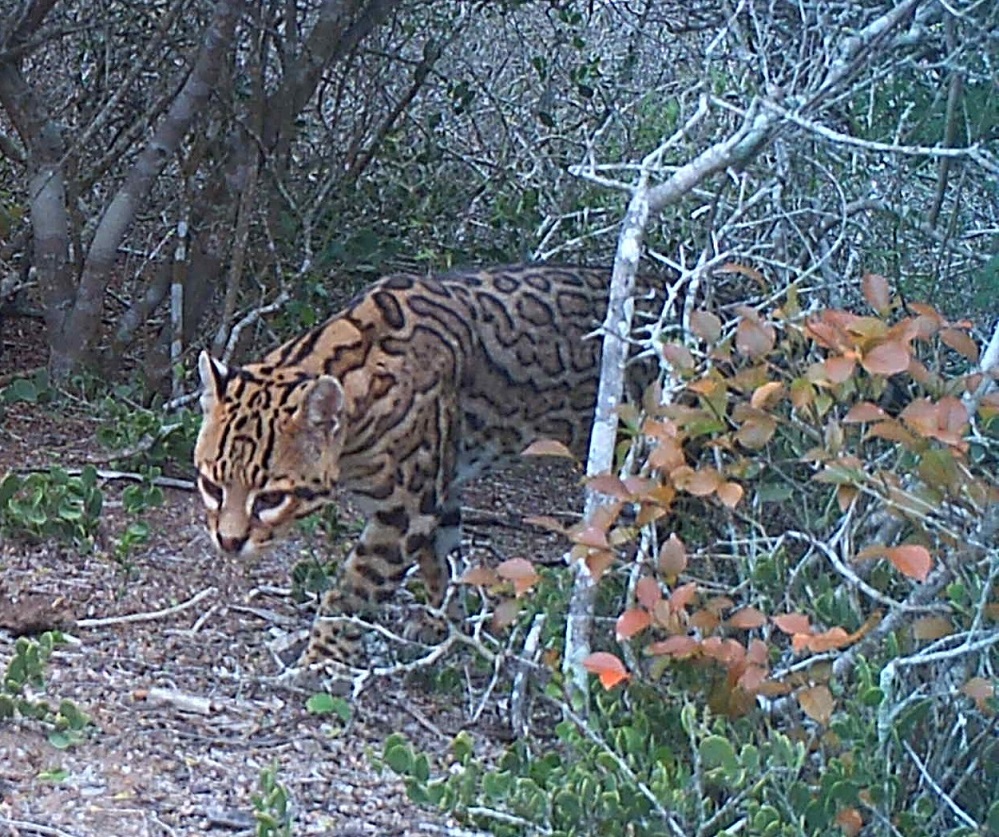Reproductive Technique Developed by Cincinnati Zoo Scientists May Help Save Critically Endangered Texas Ocelots
U.S. Fish and Wildlife Service, Texas A&M University-Kingsville, East Foundation and University of Tennessee Collaborate with Zoo to Conserve Species
 CINCINNATI (August 19, 2019) – Thanks to a novel field-ready semen banking approach pioneered by scientists from the Cincinnati Zoo’s Center for Conservation and Research of Endangered Wildlife (CREW), a wildlife biologist from the U.S. Fish and Wildlife Service (USFWS) recently collected and froze semen from a wild Texas ocelot for the first time!
CINCINNATI (August 19, 2019) – Thanks to a novel field-ready semen banking approach pioneered by scientists from the Cincinnati Zoo’s Center for Conservation and Research of Endangered Wildlife (CREW), a wildlife biologist from the U.S. Fish and Wildlife Service (USFWS) recently collected and froze semen from a wild Texas ocelot for the first time!
“That one sample contained almost 200 million sperm which is enough genetic material to potentially conduct 5-10 artificial insemination (AI) procedures,” said Dr. Bill Swanson, who directs CREW’s small cat program and chairs the Ocelot Species Survival Plan (SSP) for the Association of Zoos & Aquariums (AZA). “The U.S. ocelot population is on the edge of extinction so these efforts to collect and freeze semen from the few wild males that remain in the fragmented thorn-scrub habitat of South Texas may have important implications for their future survival.”
The entire Texas ocelot population is down to about 80 individuals, with ~15 ocelots residing in Laguna Atascosa National Wildlife Refuge (LANWR), where the sample was collected, and the remainder found on private ranchlands.
 Dr. Swanson, with assistance from Dr. Tom deMaar at the Gladys Porter Zoo, trained USFWS biologist Dr. Hilary Swarts to collect semen samples from anesthetized cats using a urethral catheter and then quickly freeze the samples as pellets directly in liquid nitrogen. The ocelot semen was collected and frozen by Dr. Swarts opportunistically in the field as part of the USFWS’s ocelot monitoring program and then shipped to CREW for storage in liquid nitrogen tanks. Post-thaw analysis of a few sample pellets revealed adequate sperm motility to fertilize domestic cat oocytes in vitro and possibly be suitable for use with AI.
Dr. Swanson, with assistance from Dr. Tom deMaar at the Gladys Porter Zoo, trained USFWS biologist Dr. Hilary Swarts to collect semen samples from anesthetized cats using a urethral catheter and then quickly freeze the samples as pellets directly in liquid nitrogen. The ocelot semen was collected and frozen by Dr. Swarts opportunistically in the field as part of the USFWS’s ocelot monitoring program and then shipped to CREW for storage in liquid nitrogen tanks. Post-thaw analysis of a few sample pellets revealed adequate sperm motility to fertilize domestic cat oocytes in vitro and possibly be suitable for use with AI.
In March, CREW demonstrated the feasibility of using frozen semen from a zoo-housed ocelot for successful AI, with the birth of two ocelot litters and three healthy kittens at the Arizona Sonora Desert Museum and the El Paso Zoo.
“By banking semen from ocelots living on both public and private lands in Texas, one primary goal of this collaborative project is to conserve as much remaining genetic diversity as possible from this endangered population for future conservation and recovery efforts,” said Swanson.
 CREW also is collaborating with Drs. Michael Tewes and Clayton Hilton of the Caesar Kleberg Wildlife Research Institute at Texas A&M University-Kingsville and Dr. Ashley Reeves at the University of Tennessee to begin collecting and banking semen from ocelots living on East Foundation properties in Texas. The East Foundation’s ranchlands are used extensively for research efforts aimed at wildlife management and rangeland health. For this project, Dr. Reeves, a veterinarian now working on her PhD, will receive training at CREW later this year in more refined reproductive techniques for semen collection, analysis, freezing, IVF and AI in cats. Her study will provide greater insight into the reproductive status of wild Texas ocelots, while concurrently recovering valuable semen for genetic banking and potential use with assisted reproduction at a later date.
CREW also is collaborating with Drs. Michael Tewes and Clayton Hilton of the Caesar Kleberg Wildlife Research Institute at Texas A&M University-Kingsville and Dr. Ashley Reeves at the University of Tennessee to begin collecting and banking semen from ocelots living on East Foundation properties in Texas. The East Foundation’s ranchlands are used extensively for research efforts aimed at wildlife management and rangeland health. For this project, Dr. Reeves, a veterinarian now working on her PhD, will receive training at CREW later this year in more refined reproductive techniques for semen collection, analysis, freezing, IVF and AI in cats. Her study will provide greater insight into the reproductive status of wild Texas ocelots, while concurrently recovering valuable semen for genetic banking and potential use with assisted reproduction at a later date.

